Camera thread sizes directly affect your lab imaging quality and equipment compatibility. Mismatched threads (like 1/4″ vs. 3/8″ UNC) can cause unstable setups, vibration, and degraded images during critical data collection. Using proper thread standards guarantees stable connections between microscopes and cameras, preventing optical path distortion and equipment damage. The right adapters can bridge incompatibilities, but direct fits offer superior stability for precision microscopy applications. Proper thread knowledge prevents costly equipment failures.
Understanding Standard Thread Sizes in Laboratory Optics
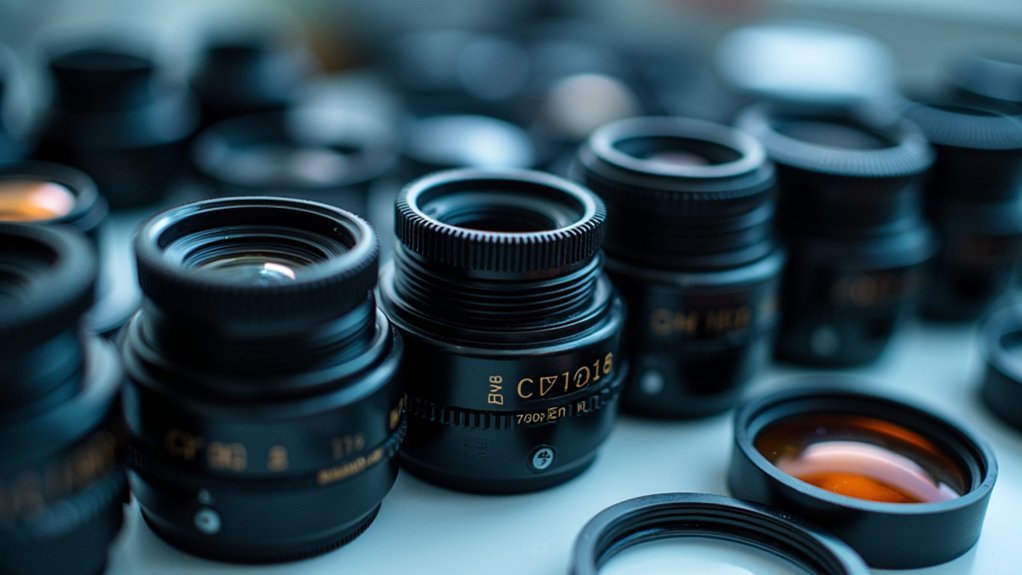
When working with laboratory cameras, you’ll quickly discover that thread sizes are a fundamental yet often overlooked aspect of optical setup. The most common tripod thread standard is 1/4 inch 20 UNC, widely used for consumer-grade cameras in lab settings.
For heavier equipment with specialized optics, the 3/8 inch 16 UNC thread provides enhanced stability and support.
Selecting the correct thread size isn’t merely a technical detail—it directly impacts your image quality and experimental results. The DIN 4503 standard guarantees interchangeability across equipment, but you’ll need to verify compatibility before mounting your camera.
While adapters can convert between sizes, they’re not ideal for precision work. Always opt for direct fits when possible to maintain stability and prevent potential damage to your sensitive laboratory imaging systems.
Common Microscope C-Mount Thread Specifications
Precision drives the standardization of C-mount threads in laboratory microscopy. When you’re connecting cameras to your microscope, you’ll encounter the industry standard 1-inch diameter with 32 threads per inch on most C-Mount lens systems. This screw thread specification guarantees compatibility across various imaging equipment.
Your fixed lens microscope likely utilizes this robust thread design specifically to support camera weight while maintaining optical alignment.
The robust C-mount thread design ensures your microscope supports camera weight while maintaining precise optical alignment throughout experiments.
You’ll find adapters readily available if you need to convert between C-mount and other thread sizes like 1/2 inch or 1/4 inch for specialized camera models.
For ideal image quality, you must properly align and securely attach the C-mount.
Many systems now include additional thread adapters, increasing versatility and allowing you to connect different camera types to your existing laboratory microscope.
Compatibility Challenges Between Camera Brands and Microscopes
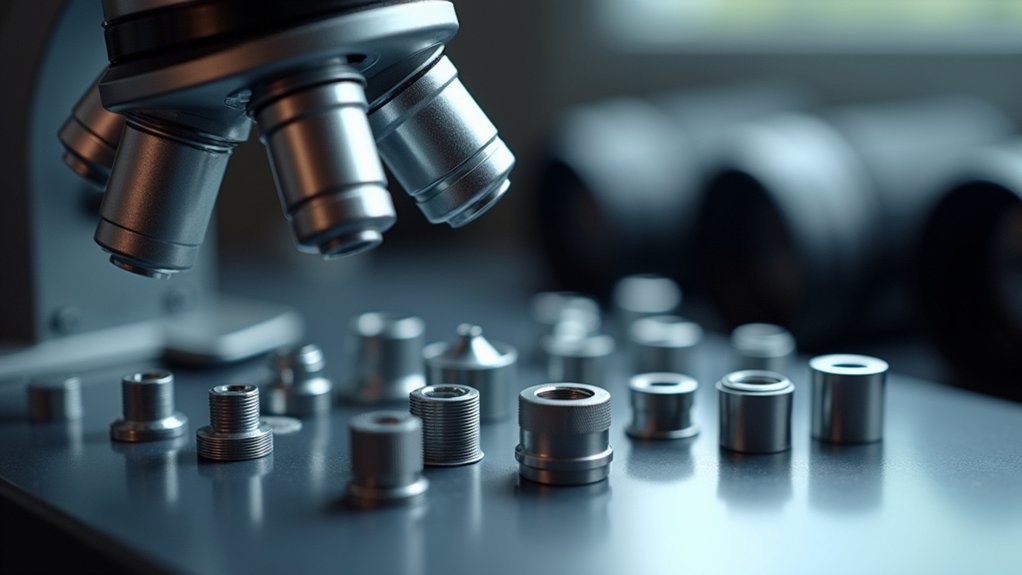
Integrating cameras with microscopes presents significant compatibility challenges, especially when dealing with mismatched thread sizes. Your consumer camera likely uses a 1/4 inch 20 UNC thread, which often doesn’t align with microscope mounts using 3/8 inch 16 UNC threads. This mismatch can prevent proper lens alignment and stable imaging.
When connecting equipment from different manufacturers, you’ll need to verify thread compatibility carefully. Many microscopes follow the DIN 4503 standard, but legacy equipment may feature non-standard threads that complicate integration.
Medium format and professional cameras particularly may not readily attach to standard microscope mounts. You’ll often need adapters to bridge these differences, but make sure they don’t compromise stability.
Professional-grade microscopes typically use higher-quality thread fittings that may require specialized solutions when pairing with cameras from diverse brands.
The Critical Role of Thread Adapters in Lab Imaging
Thread adapters serve as essential bridges between your lab camera’s mounting thread and specialized microscope equipment, preventing the frustration of incompatible connections.
You’ll need these precision-machined converters when shifting between standard tripod mounts (typically 1/4″ or 3/8″ UNC threads) and the proprietary threaded systems found on research-grade optical instruments.
When you encounter thread size mismatches, the right adapter doesn’t just enable the connection—it guarantees your imaging setup remains stable for critical high-magnification photography where even minor vibrations can ruin your results.
Microscope Mounting Compatibility
When connecting cameras to microscopes in a laboratory setting, you’ll quickly discover that thread compatibility becomes a critical consideration. Most microscope mounts use either 1/4 inch 20 UNC or 3/8 inch 16 UNC threads, but variations between manufacturers can impact focal distance and overall system stability.
- Thread mismatches can damage both your microscope and camera equipment.
- Legacy microscopes often require special adapters to work with modern cameras.
- Proper adapters maintain ideal focal distance for clear imaging.
- Cross-brand setups almost always necessitate thread adapters.
- Investing in quality adapters is more cost-effective than replacing damaged equipment.
Don’t assume compatibility between different brands or models.
The right thread adapter not only protects your equipment but guarantees your imaging system performs at its best during critical laboratory work.
Standard-to-Specialty Conversions
Laboratory imaging presents unique challenges as you move between standard and specialty equipment, making thread adapters essential infrastructure rather than optional accessories. When your microscope camera uses 1/4″ threads but your precision mounting system requires 3/8″ connections, you’ll need reliable adapters to bridge the gap.
| Adapter Type | Common Use | Reliability Rating |
|---|---|---|
| 1/4″ to 3/8″ | Camera to heavy tripod | Excellent |
| 3/8″ to 1/4″ | Lighting to standard mount | Very Good |
| Specialty Converters | Custom lab setups | Good |
Always verify thread compatibility before purchasing adapters. While direct fits offer ideal stability, quality adapters provide nearly equivalent performance without requiring new equipment purchases. You’ll find this approach particularly valuable when integrating larger specialty equipment that depends on 3/8″ UNC threads into your existing lab photography system.
Thread Size Mismatches
Even the most advanced laboratory imaging system can fail catastrophically if you overlook critical thread size compatibility issues.
When your camera’s 1/4-inch thread meets a tripod designed for 3/8-inch connections, you’re risking equipment stability and potentially costly damage.
- Thread adapters provide solutions for mismatched components but introduce potential failure points
- The 1/4-inch (20 UNC) standard works for most consumer cameras in lab settings
- Heavier equipment typically requires the sturdier 3/8-inch (16 UNC) threads
- Quality adapters can safely bridge compatibility gaps when direct fits aren’t possible
- You’ll achieve greater stability by selecting equipment with matching threads rather than relying on converters
While adapters offer convenient workarounds, you’ll maximize your lab photography reliability by prioritizing direct thread compatibility whenever possible.
Essential Thread Conversion Measurements for Precision Microscopy
When converting between different thread standards for your microscopy equipment, you’ll need an accurate thread standards comparison chart to identify the precise measurements for each mounting system.
Selecting the right adapter requires understanding both the pitch and diameter compatibility between your camera and microscope, which can mean the difference between stable imaging and frustrating results.
The right measurement tools, including thread gauges and digital calipers, will help you confidently determine the exact specifications needed for your particular laboratory photography setup.
Thread Standards Comparison Chart
Precision microscopy depends on having the right connections between your camera and equipment.
When selecting thread adapters for your lab photography setup, you’ll need to know exactly which standards are compatible. The most widely used threads are 1/4″ 20 UNC for consumer cameras and 3/8″ 16 UNC for heavier equipment.
- 1/4″ 20 UNC (standard consumer thread): Compatible with most tripods and lightweight microscope adapters
- 3/8″ 16 UNC: Ideal for professional-grade equipment and heavier camera bodies
- DIN 4503: European standard often found in precision laboratory equipment
- Direct thread connections: Provide maximum stability compared to adapter solutions
- Thread pitch compatibility: Essential for preventing equipment damage and ensuring secure attachments
Understanding these standards will save you time troubleshooting connection issues and protect your valuable equipment from potential falls or damage.
Adapter Selection Fundamentals
Selecting the right thread adapters forms the foundation of effective lab photography. You’ll primarily encounter two standard sizes: 1/4″ 20 UNC and 3/8″ 16 UNC, which must match perfectly between your camera and microscopy equipment.
| Adapter Type | Best Use Case | Reliability | Cost | Compatibility |
|---|---|---|---|---|
| Direct fit | Premium equipment | Highest | $$$ | Equipment-specific |
| Thread converter | Mixed equipment | Good | $$ | Universal standards |
| Stepped adapter | Field work | Moderate | $ | Multiple sizes |
| Quick-release | Frequent changes | Very good | $$$ | Brand-specific |
| Extension adapter | Special setups | Moderate | $$ | Limited application |
While adapters provide inexpensive solutions, direct fits offer superior stability. Always verify thread measurements before purchase—DIN 4503 standards guarantee interchangeability with UNC threads across most lab photography setups, preventing costly equipment damage during sensitive imaging procedures.
Measurement Tools Guide
Now that you understand adapter fundamentals, you’ll need proper tools to verify thread specifications before connecting expensive equipment.
Accurate measurement prevents damage to your camera and microscope components while guaranteeing stable imaging results. Never guess thread sizes when precision matters for scientific documentation.
- Thread pitch gauges to verify UTS standards (1/4-20 UNC and 3/8-16 UNC measurements)
- Digital calipers for measuring thread diameter to 0.01mm precision
- Thread identification charts comparing DIN 4503 standard specifications
- Thread depth measurement tools to guarantee proper engagement
- Magnifying loupe (10x) for visual inspection of existing thread condition
Remember that even minor measurement errors can lead to cross-threading or unstable connections, compromising your imaging quality.
Quality measurement tools are an investment that protects your expensive microscopy equipment while delivering the clarity required for publication-quality results.
How Thread Mismatches Impact Image Quality and Data Collection
When you’re conducting laboratory photography, even subtle mechanical issues can considerably compromise your results. A mismatch in tripod thread sizes creates unstable camera setups that introduce vibrations, degrading image quality during critical data collection.
If you’re using adapters to reconcile different thread sizes, you’re adding potential failure points that can affect image sharpness. Improper thread compatibility causes inconsistent alignment that distorts the optical path, resulting in inaccurate data representation.
Watch your weight distribution carefully; mounting a larger lens on an undersized thread can cause your camera to shift, reducing focus accuracy in macro photography.
Selecting the Right Camera Thread for Your Laboratory Application
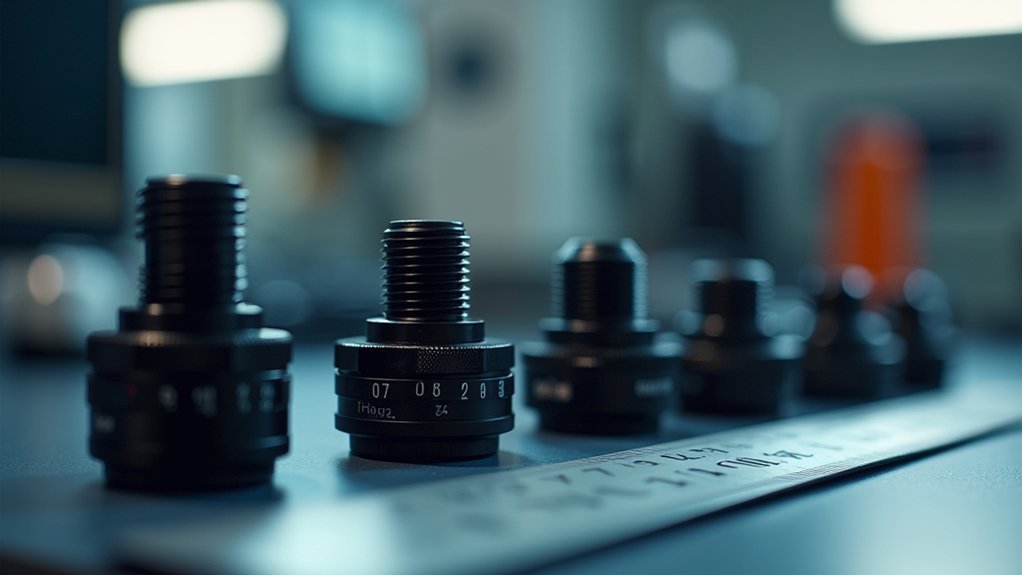
The success of your laboratory imaging largely depends on choosing appropriate thread sizes that match your specific application requirements.
Precise thread selection ensures optimal laboratory imaging results and prevents costly equipment incompatibilities.
You’ll need to verify if your camera uses the standard 1/4 inch 20 UNC thread or requires the more robust 3/8 inch 16 UNC option for heavier setups.
- Determine your camera’s weight including lens and accessories before selecting mounting equipment
- Check that all components conform to DIN 4503 standards for seamless integration
- Consider direct-fit options over adapters whenever possible for maximum stability
- Verify thread compatibility when purchasing new equipment to avoid workflow disruptions
- Match thread size to the specific type of laboratory photography you’re conducting (macro vs. standard documentation)
Don’t compromise your data quality with mismatched threads—proper selection guarantees stable, precise imaging results.
Troubleshooting Thread Engagement Issues in Microscope Setups
Despite careful selection of camera components, thread engagement problems can still plague your microscope imaging setup. When your camera won’t securely attach to your microscope, you’ll need to methodically identify the source of the problem.
| Issue | Solution |
|---|---|
| Incompatible threads | Verify both use standard sizes (1/4″-20 UNC or 3/8″-16 UNC) |
| Contamination | Clean threads thoroughly before connection |
| Thread damage | Inspect regularly for wear; replace damaged components |
| Alignment difficulties | Use extension tubes or adjust mounting position |
Don’t overlook the importance of thread cleanliness—even microscopic debris can prevent proper engagement. If direct mounting isn’t working, consider using a thread adapter, but remember this may introduce stability issues. Regular inspection of your equipment’s threads will help prevent connection failures during critical imaging sessions.
Thread Standards Across Different Microscope Manufacturers
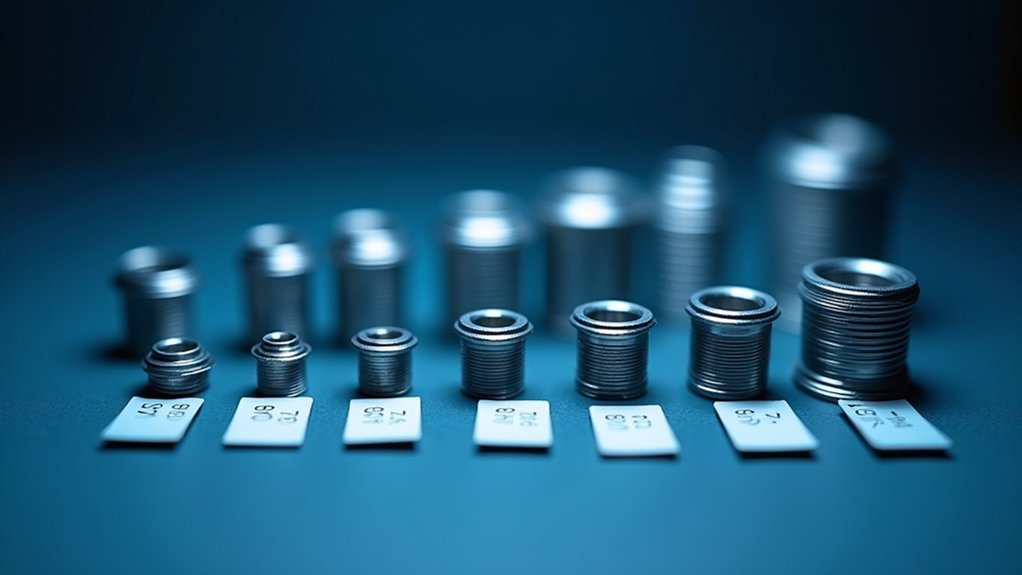
When working with equipment from different manufacturers, you’ll find that thread compatibility varies considerably between brands, with some following standardized DIN 4503 or UNC specifications while others implement proprietary designs.
You’ll need to identify your microscope’s exact thread type before purchasing a camera to guarantee proper mounting, as mismatched threads can damage both pieces of equipment.
Specialized adapters are often required to bridge incompatible systems, particularly when connecting newer cameras to older microscope models or when crossing between manufacturers with different thread standards.
Compatibility Between Brands
Because manufacturers often follow different design philosophies, traversing thread standards across microscope brands can be challenging for lab photographers.
You’ll need to verify your equipment’s specifications before purchasing cameras or accessories to guarantee proper fit and performance. While the 1/4 inch 20 UNC thread is common across most systems, you may encounter DIN 4503 or 3/8 inch 16 UNC specifications depending on the manufacturer and equipment size.
- Thread adapters can bridge compatibility gaps between different brands
- Older microscope systems may not conform to modern thread standards
- Reputable manufacturers typically adhere to established standards for wider compatibility
- Mixing equipment across brands often requires additional connectors or adapters
- Always check both camera and microscope thread specifications before making purchasing decisions
Specialized Adapter Requirements
Although most microscope manufacturers claim to follow industry standards, you’ll find significant variations in thread specifications across different brands and models.
These differences often follow either DIN 4503 or UNC standards, creating potential compatibility issues when connecting cameras to your microscope.
You’ll need to verify thread specifications before purchasing any adapter, as mismatches can compromise both connection security and image quality.
While adapters are generally affordable and readily available, direct-fit options provide superior stability for your expensive equipment.
This becomes particularly important when working with legacy microscopes that don’t conform to modern thread standards.
In these cases, specialized adapters aren’t just convenient—they’re crucial.
Don’t assume compatibility based solely on brand; always check the exact thread measurements to ascertain proper fit and prevent damage to your camera or microscope components.
Practical Solutions for Camera-to-Microscope Integration
Most laboratory imaging setups face the common challenge of physically connecting cameras to microscopes.
You’ll need to verify thread compatibility before purchasing equipment, as the standard 1/4 inch 20 UNC thread is common for consumer cameras but not universal across all microscope brands.
When threads don’t match, invest in high-quality adapters specifically designed for your equipment combination.
- Use dedicated microscope camera mounts to eliminate vibration during image capture
- Consider specialized macro photography attachments that maintain thread compatibility
- Install a stable tripod system when working with heavier camera equipment
- Purchase thread-specific adapters before your imaging session to avoid delays
- Test all connections for stability before conducting critical imaging work
These practical approaches will guarantee your imaging system remains secure and properly aligned throughout your documentation process.
Future-Proofing Your Lab: Thread Standardization Trends
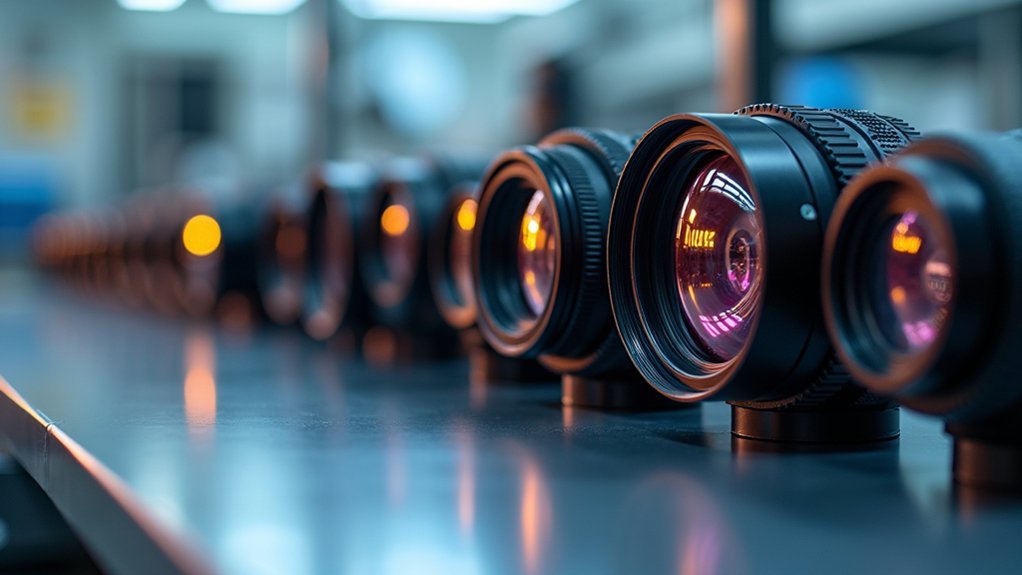
As integration challenges become more complex, forward-thinking laboratories need to contemplate thread standardization trends. By adopting equipment with 1/4 inch 20 UNC and 3/8 inch 16 UNC threads, you’ll guarantee compatibility across multiple brands, minimizing frustrating equipment mismatches.
| Thread Standard | Benefits | Future Outlook |
|---|---|---|
| 1/4″ 20 UNC | Universal camera mount | Remains industry standard |
| 3/8″ 16 UNC | Higher load capacity | Preferred for heavier equipment |
| ISO 1222:2010 | International compliance | Increasing adoption rate |
| M6 Metric | European compatibility | Growing in specialized applications |
| T-Thread | Microscope-specific | Evolving for digital integration |
You’ll streamline your inventory by prioritizing standardization, eliminating adapters that compromise stability. This approach not only enhances current equipment interoperability but simplifies integration of emerging technologies and training procedures for your staff.
Frequently Asked Questions
What Thread Size Do Cameras Use?
Your camera typically uses a 1/4-inch 20 UNC thread for tripod mounting. If you’re working with heavier equipment, you’ll need the larger 3/8-inch 16 UNC thread for proper stability and support.
What Is the Standard Camera Lens Thread Size?
The standard camera lens thread size you’ll find on most consumer cameras is 1/4 inch 20 UNC. It’s widely used for mounting your camera securely to tripods and other stabilizing equipment.
Are Camera Threads Universal?
No, camera threads aren’t universal. You’ll encounter mainly 1/4-20 UNC (consumer cameras) and 3/8-16 UNC (professional equipment). Always check specifications before purchasing accessories, as variations exist between brands and equipment types.
What Thread Is Used for Cameras?
Most cameras use a 1/4 inch 20 UNC thread for tripod mounting, while heavier professional setups might use a 3/8 inch 16 UNC thread. You’ll find these standards on nearly all camera equipment worldwide.
In Summary
You’ll save yourself time, money, and frustration by understanding camera thread standards in your lab setup. Don’t overlook these seemingly minor technical details—they’re essential for achieving ideal imaging results. Keep thread adapters handy, document your equipment’s specifications, and stay informed about evolving standards. When your imaging components connect properly, you’ll capture the precise scientific data your research demands.





Leave a Reply